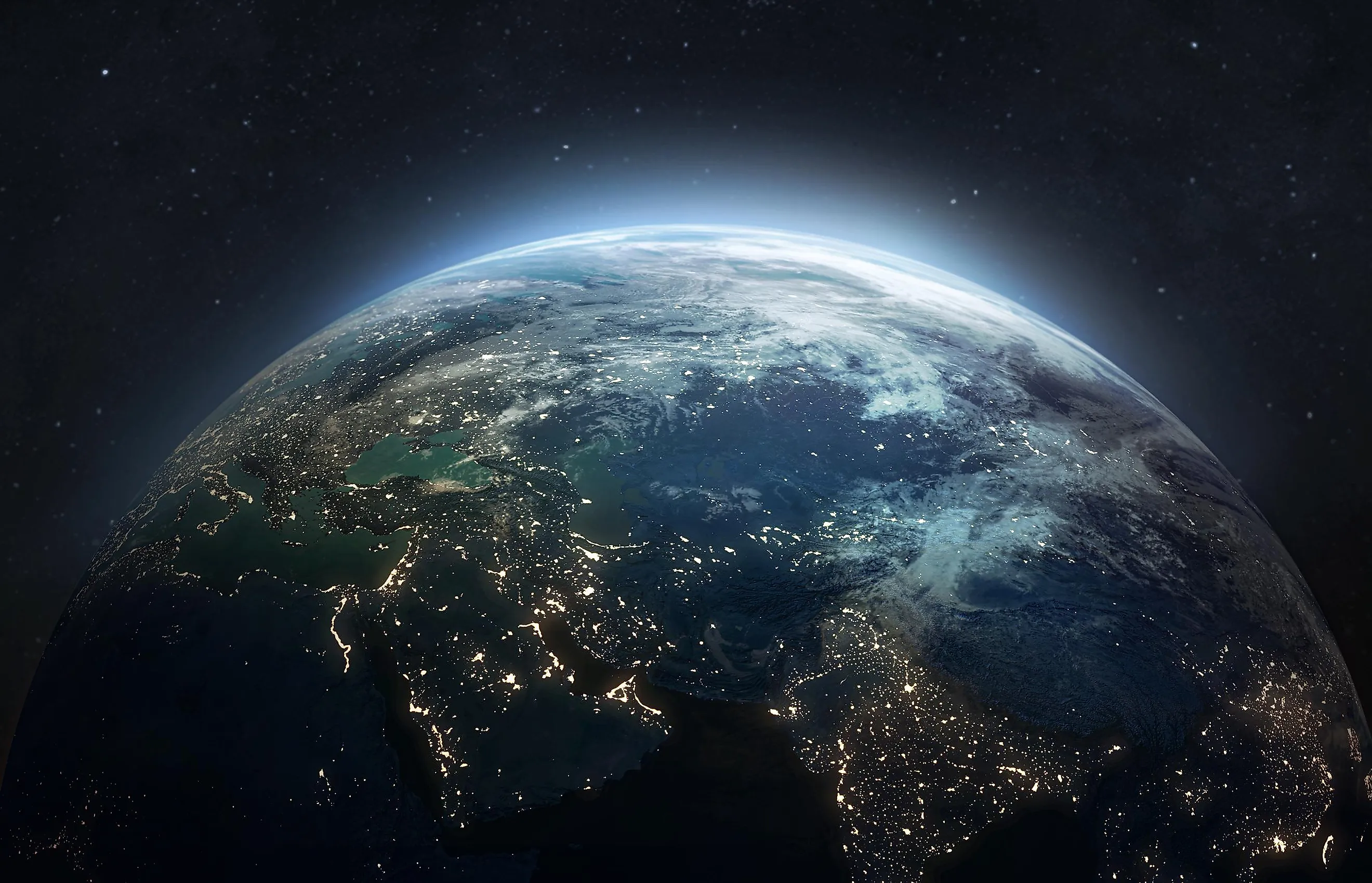
Earth
Earth is the home-world of the human species and all known life forms. It is also perhaps the most unique planet that we know of. Not only is it home to life, but it also has a rather strange atmosphere and a surface covered in liquid water. When viewed from space, the Earth stands out as an oasis against the vast emptiness of space.
Earth is the fifth-largest planet in the solar system and the largest of the inner rocky worlds. The Earth is 7,926 miles (12,756 kilometers) in diameter. It is 93 million miles (150 million kilometers) away from the sun, or what astronomers call an astronomical unit. The average surface temperature on Earth is a moderate 59 degrees Fahrenheit (15 degrees Celsius), allowing for the existence of liquid water on the surface. Acceleration due to the Earth's gravitational force is 9.81 m/s^2 (32.2 ft/s^2), meaning that objects will fall at a rate of 9.81 meters for every second they drop. Earth's atmosphere is primarily composed of nitrogen and oxygen, with nitrogen comprising 78% of the atmosphere and oxygen 21%. The remaining 1% is a combination of several other elements and compounds, the most notable of which are argon, carbon dioxide, water vapor, and methane.
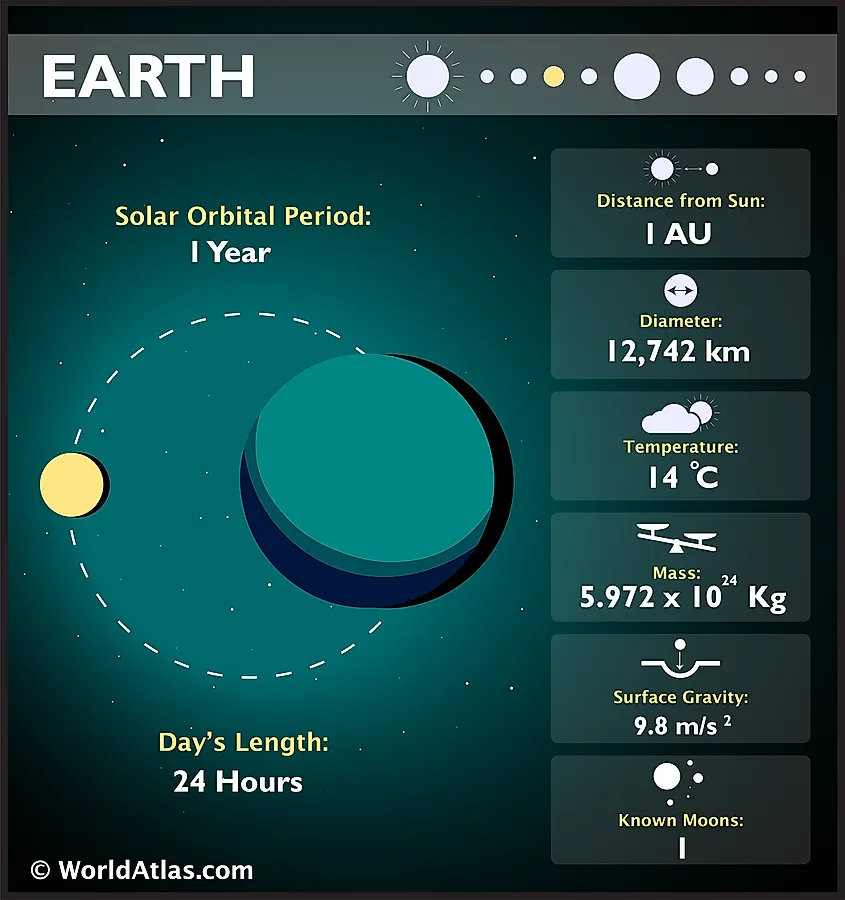
Formation Of The Earth
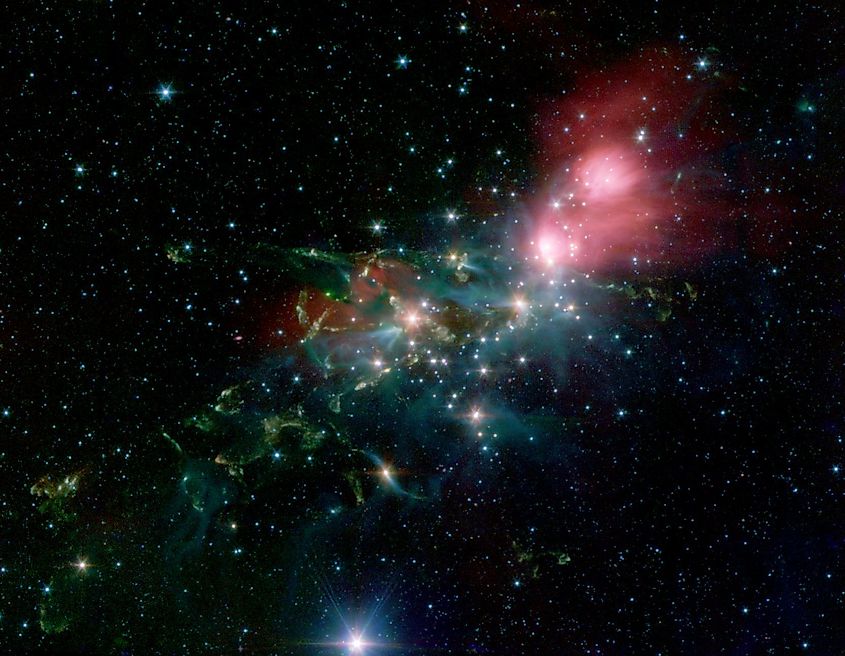
The Earth formed 4.5 billion years ago, shortly after the sun's birth. Out of the stardust that created the sun, a vast disk of material emerged called a protoplanetary disk. Gas and dust gradually coalesced together within this disk to form small objects called planetesimals. In terms of size, a planetesimal is similar to an asteroid or comet, yet its composition is like a miniature planet. Over millions of years, enough planetesimals will combine to form a small planet. As the planet grows more massive, its gravitational pull grows in strength, allowing the forming planet to bring in more material and grow even larger. The process becomes exponential until there is no more material to collect, and a planet is born. This is how the Earth likely formed.
After the Earth became a planet, it was a very harsh environment. There was no water on the surface, no oxygen in the atmosphere, and life had not yet taken hold. For the first few hundred million years, the Earth was covered in magma, constantly occurring volcanic eruptions. Asteroids were still constantly bombarding the surface during an era known as the Late Heavy Bombardment. However, it did not take long for the Earth to become habitable. The earliest evidence of life indicates that it arose between four to three billion years ago. The earliest concrete evidence of living organisms places their existence during the Late Heavy Bombardment. The conditions necessary for the evolution of life were present not long after the Earth itself formed.
Formation Of The Moon
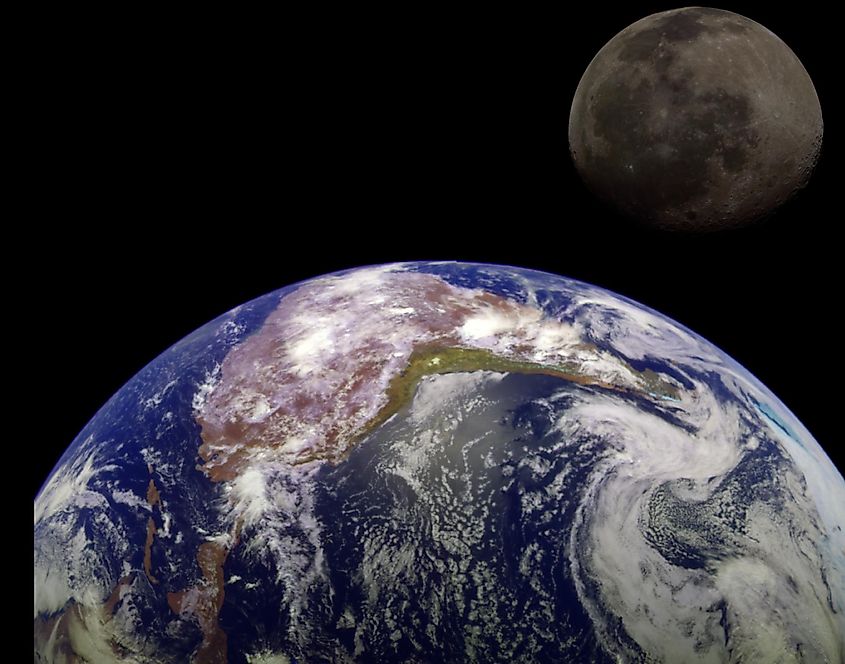
The moon formed not long after the Earth: around 4.5 billion years ago. For decades, the formation of the moon was a mystery for astronomers. Although it may not look like it, our moon is very unique among the worlds in our solar system. Relative to the planet's size, it orbits, our moon is the largest in the solar system. The Earth is also the only rocky world in the solar system that possesses its large moon. Neither Mercury nor Venus has moons, and the moons of Mars are tiny compared to our moon. Perhaps the moon was another forming planet that happened to get captured by Earth's gravity. Maybe it simply formed from planetary debris in orbit. Astronomers debated these and other questions for decades. When astronauts finally arrived on the lunar surface in the late 1960s and early 1970s, astronomers found definitive evidence about the moon's origin. Lunar samples brought back to Earth revealed a surprising chemistry. Although lunar rocks were different, they contained a remarkable resemblance to rocks on Earth. This forced astronomers to look at an exciting yet somewhat outlandish theory.
The moon likely formed during a planetary collision when a Mars-sized planet called Theia impacted the Earth some 4.5 billion years ago. The clash between these planets would have sent a tremendous amount of debris from both worlds into orbit. The moon contains rocks similar to Earth rocks and others that are different. This suggests that the collision sent debris from both the Earth and Theia into orbit. Over time, this debris began to coalesce into our moon.
The Oceans
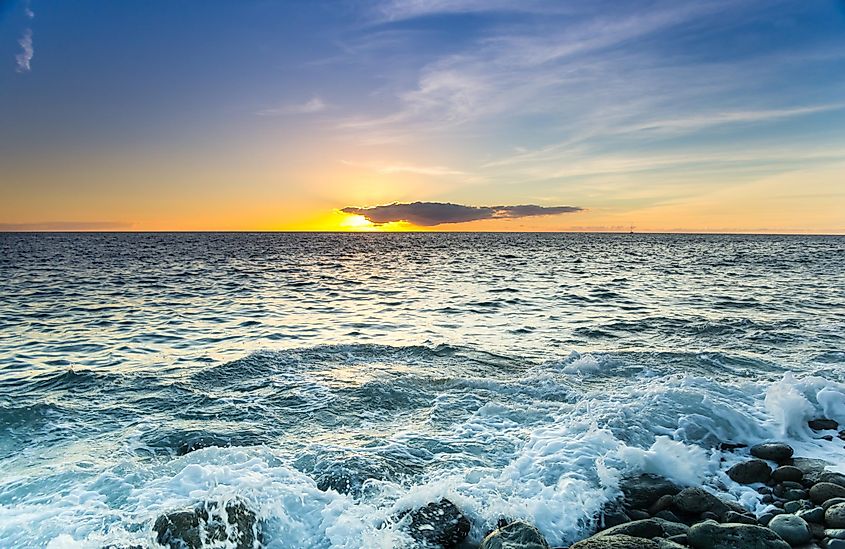
When viewed from space, the most striking feature of the Earth is its vast oceans. The Earth is unique in that it is the only known world that possesses oceans of liquid water. Earth is fortunate enough to orbit within the sun's habitable zone, the region around the sun where, given the proper conditions, water can exist in liquid form. However, location isn't everything. Earth had to get its water from somewhere. Comets and asteroids likely provided the Earth with some of its water. Yet, evidence suggests that comets and asteroids alone would not have been sufficient enough to provide the Earth with the amount of water it contains. Furthermore, studies of comets have confirmed that their water is slightly different from that of the Earth's, so there were likely multiple processes at play that resulted in Earth having so much water. It's also possible that most of Earth's water has always been here and was simply part of the material that formed the Earth.
Water may have always been part of the Earth, yet at what point did it become liquid and form the oceans? Some of the oldest known rocks on Earth show clear evidence of liquid water, and so Earth may have had liquid on its surface as early as four billion years ago. Most of this liquid water was likely in the form of shallow seas and ponds. Around 3.8 billion years ago, the Earth cooled enough for the first oceans to form.
Today, water covers about 70% of the Earth's surface, with the vast majority of that water belonging to one of Earth's many oceans.
Cycles
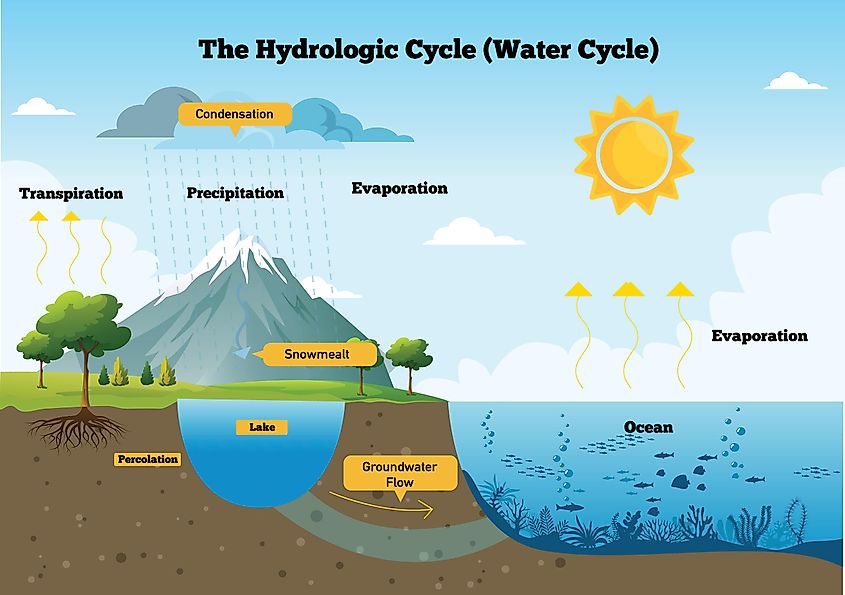
Over many hundreds of millions of years, every rock on Earth will be recycled through a process called the rock cycle. It begins with volcanic rock. Volcanoes are tunnels that lead to Earth's molten interior, where rock is melted to form magma. When a volcano erupts, magma makes its way to the surface and solidifies to form igneous rock. Natural processes erode this rock to form sediment over many millions of years. If the sediment becomes buried under immense pressure, it cements and forms sedimentary rock. If that sedimentary rock is buried and heated to extreme temperatures, it will transform into metamorphic rock. If the metamorphic rock is buried and melted, it becomes magma, and the process restarts. Interestingly, any type of rock can become any other type by skipping the process. For example, sedimentary rock could melt and then solidify to form igneous rock, or metamorphic rock could erode and become sediment. Every rock you have ever encountered was magma that solidified to become igneous rock at some point in the past. Over time, all rocks on Earth are recycled. Most of the burial occurs at subduction zones, where rock is returned to the Earth's interior only to be released by a volcanic eruption to restart the rock cycle. On continents, rocks are eroded either by wind or water and are eventually transported to regions where one day they will find themselves in a subduction zone. Since the Earth is 4.5 billion years old, every rock you have ever seen has gone through the entirety of the rock cycle. Next time you pick up a rock or kick one down the street, think about how the material that makes up that rock was once deep within our planet at some point in the distant past.
Over the last 4.5 billion years, the Earth has evolved a series of different cycles that recycle the material contained within our world. Since the Earth is a closed system, nature has devised several ways to ensure the total amount of stuff stays relatively constant through time. If it were not for these cycles, life on Earth would not be able to exist as the Earth's resources would be quickly consumed. Out of all these cycles, two have always stood out to me as mind-boggling and beyond fascinating: the carbon and water cycles.
The water cycle is interesting because we can observe it in our daily lives. On a hot day, we can see water evaporate. On a rainy day, we see that same waterfall comes back to the surface. Over time, the total amount of water on Earth has stayed relatively constant. When temperatures go up during the summer, water evaporates into the atmosphere to form clouds. Eventually, the pressure in the atmosphere goes up with all this extra water content and falls back to the surface as rain or snow. When the temperature goes up again, the process repeats itself. Life has even added its factors to the water cycle. Plants and animals use water to survive, and plants will even release some of that water back to the atmosphere through transpiration. Eventually, all of the Earth's water will be recycled and returned. In fact, you have very likely drank water that once passed through the bladder of a dinosaur. Every time you fill a cup of water, every molecule of water in that cup has been recycled over the last few billion years. Within every cup of water, there is a long history of where those molecules have been to make their way to you eventually.
The majority of Earth's carbon is stored in rocks, yet how does it get there, and how is it released? This is where we find a connection between the water and carbon cycles. When it rains, carbon dioxide is dissolved in the rainwater. When that rain falls onto rocks, the raindrops can become absorbed in the small cracks and crevices of the rocks. Along with the water, the carbon is also stored within the rock. Over many years, those rocks are broken down, and the carbon makes its way back into the environment. Things that absorb carbon, such as rocks, are called carbon sinks, and they help maintain a reasonably constant amount of carbon in the atmosphere. In addition to rocks, another large carbon sink is the oceans. Carbon dioxide can also be absorbed by the oceans, which helps to stabilize Earth's greenhouse effect. Forests are another large carbon sink, wherein trees and other plants absorb carbon dioxide from the atmosphere to produce their energy. When the trees die, that carbon is returned to the Earth. Like water, every atom of carbon, even the carbon that makes up most of your body, has likely gone through the carbon cycle multiple times. The carbon that makes you may have once been used in making a dinosaur, or maybe it was once absorbed in the rocks or the ocean. Within each of us lies the story of our world.
Plate Tectonics
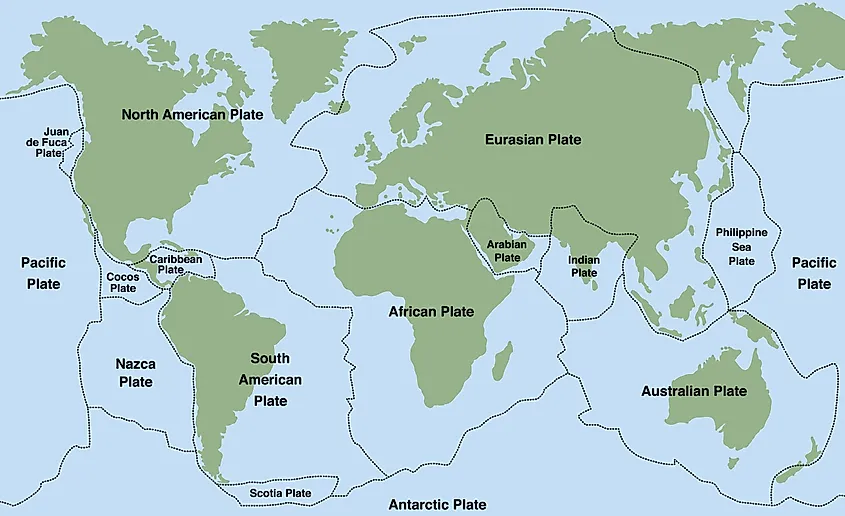
When you look at a map of the Earth, perhaps you've noticed how all the continents almost look like puzzle pieces. If you could move the continents, they would fit together rather nicely. This isn't just pure coincidence. Many millions of years ago, all the land masses on Earth were joined together in Pangea's supercontinent. If you could travel back in time to over 200 million years ago, you would not see multiple continents spread out across the Earth. Instead, you would see one continent surrounded by a gigantic, singular ocean. The world of the past is alien to us; the very surface of our planet is unrecognizable. How did we end up where we are today, with seven continents now divided across Earth's surface? Throughout many millions of years, the continents themselves move across the surface through a process called plate tectonics.
To understand plate tectonics, we must first take a trip through the inner layers of our world. We humans, along with all other forms of life, find ourselves on the Earth's outer crust. Despite the crust being the most significant layer in our daily lives, it comprises an extraordinarily tiny percentage of the Earth. On average, the crust is 30 km thick on the continents. In the oceans, it's even thinner, averaging at only 5 km thick. When compared to the total volume of our planet, the crust makes up less than 1% of the Earth's total volume. If the Earth were the size of an apple, the crust would only be as thick as the apple's skin. That truly is remarkable to think about. Every event in the history of life on Earth has occurred on this minuscule layer of rock. What goes on underneath the crust is responsible for what happens to the crust over time. If you could travel below the crust, you would enter a layer of Earth called the lithosphere.
Beneath the crust, pressures, and temperatures are far higher than they are above, although they are not high enough to completely melt rock to form magma. Instead, the rock beneath the crust is more ductile and malleable, kind of like a highly viscous toothpaste. Over millions of years, this elastic form of rock flows and moves. In the lithosphere, rock may flow over time, although it's still too dense for it to happen efficiently. Below the lithosphere, we encounter the asthenosphere. Here temperatures and pressures can partially melt rock and allow it to flow and move much more easily than in the lithosphere. The asthenosphere is what causes the crust above to shift over time. The flowing rock literally carries the ground above it, moving it like a conveyor belt. The lithosphere and asthenosphere comprise most of what we know as Earth's mantle: a layer of partially melted rock that reaches 2,900 km into the Earth.
Beneath the mantle is the outer core. Here temperatures exceed those of the sun's surface, allowing metals such as iron and nickel to exist in liquid form. Beneath the outer core is the most mysterious layer of our world: the inner core. Although temperatures in the inner core are higher than those in the outer core, the sheer amount of pressure stops iron and nickel from becoming liquid. Instead, the Earth's core is a spinning ball of solid iron and nickel. The movement of iron in Earth's core generates the magnetic field that encompasses our world, protecting us from deadly radiation coming from both the sun and interstellar space.
Formation And Evolution Of Life
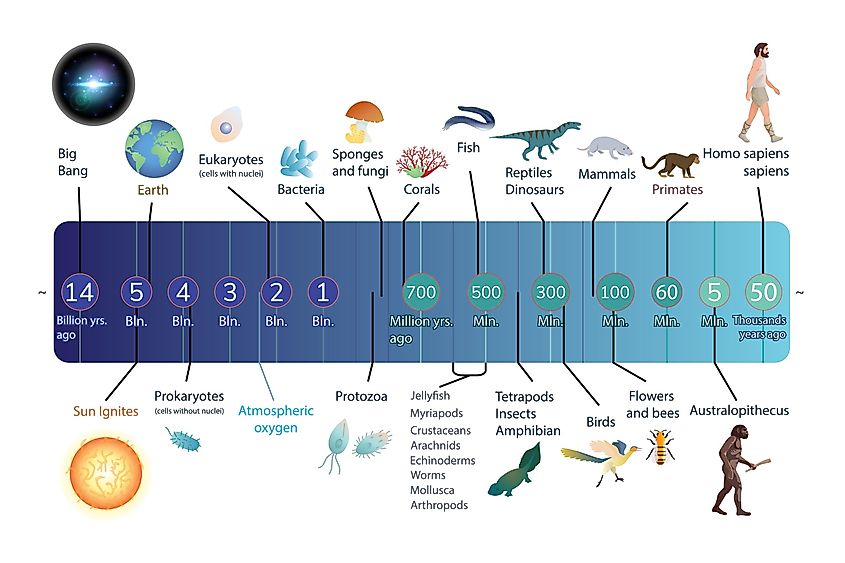
The history of life on Earth is a history of challenge and change. The earliest concrete evidence of life places its origin around 3.5 billion years ago. Yet, some indirect forms of evidence place their roots even further back to about 4.2 to 4 billion years ago (indirect evidence comes in the form of chemical evidence rather than fossils). We know that at some point in the last 4-billion years, something happened wherein there was no life, and then there was. Interestingly, even if we take only concrete fossil evidence of life 3.5 billion years ago, life seemingly arose in harsh conditions. At this time, the Earth was not the habitable oasis we find ourselves in today. Instead, temperatures were far hotter, the atmosphere had little to no oxygen, and asteroids were plummeting towards the Earth at a far higher rate than today. Despite these hellish conditions, life arose and began to evolve. A lot of what happened at the moment life began remains a mystery. How did nonliving chemicals evolve into life? What conditions did this happen under? Did it happen more than once? For now, science has no definitive answer to any of these questions. Yet, our lack of understanding and willingness to admit our intellectual limitations is part of what makes science so unique. We don't have to pretend to know things; we must simply keep looking and follow the evidence wherever it leads.
To find out where life may have started, we have to look for three things. First, were the right chemicals present? Second, was there a sufficient energy supply to power chemical reactions and move them along? Thirdly, was water present? Thankfully, there were multiple places on the young Earth where these three conditions were met. Firstly, the right chemicals notably include organics, all primarily based on carbon. Carbon forms the basis of all life on Earth because it can make a vast diversity of molecules, stemming from the fact that carbon can form four covalent bonds at once, making it a fantastic element to use in chemical reactions. All organic compounds are based on carbon and its ability to form covalent bonds. Thankfully, the young Earth had no shortage of organic molecules. Secondly, energy to push the reactions forward could have come in the form of lightning in Earth's atmosphere or from hydrothermal vents on the ocean floor. Thirdly, the reaction needs a solvent to mix everything for the reaction to make life. Water is truly the universal solvent, having the ability to dissolve pretty much anything given enough time. Water's remarkable ability to be such a strong solvent results from its strong polarity as a molecule. Water is composed of two hydrogen atoms and one oxygen atom, with the hydrogen having a positive charge and the oxygen having a negative charge. This makes water its own magnet, allowing it to dissolve and mix many other chemicals. The first oceans on Earth showed up around 3.8 billion years ago, so Earth had no water shortage.
When it comes to where life originated, there are two leading ideas. First, life arose near the surface in small pools of liquid water and organics. In this scenario, lightning in Earth's atmosphere provided the energy needed to kickstart and continue the reaction. Second, and this is perhaps the current leading theory on life's origin, life arose at the bottom of the ocean in and around hydrothermal vents. Earth's internal heat powers hydrothermal vents, which are very rich in organics. Even today, at the bottom of Earth's oceans, hydrothermal vents offer an oasis for organisms that find themselves living in a world of darkness. Interestingly, hydrothermal vents would solve many of the problems that arise with the origin of life, notably the observation that life still appeared relatively quickly after the Earth became even remotely habitable despite such extreme conditions on the surface. If life originated under the oceans near hydrothermal vents, it didn't necessarily matter how harsh conditions were on the surface because life wasn't exposed to them.
Earth Fact Sheet
| Diameter | 7,926 miles (12,756 kilometres) |
|---|---|
|
Mass |
1.317 x 10^25 pounds (One Earth) |
|
Moons |
One |
|
Distance from the sun |
93 million miles (150 million kilometres) |
|
Length of year |
365 days |
|
Length of day |
24 hours |
|
Surface temperature |
59 degrees Fahrenheit (15 degrees Celsius) |
|
Atmospheric composition |
78% nitrogen, 21% oxygen, argon, carbon dioxide, water vapor, methane |
|
Surface composition |
Iron, silicon, aluminum, nickel |











